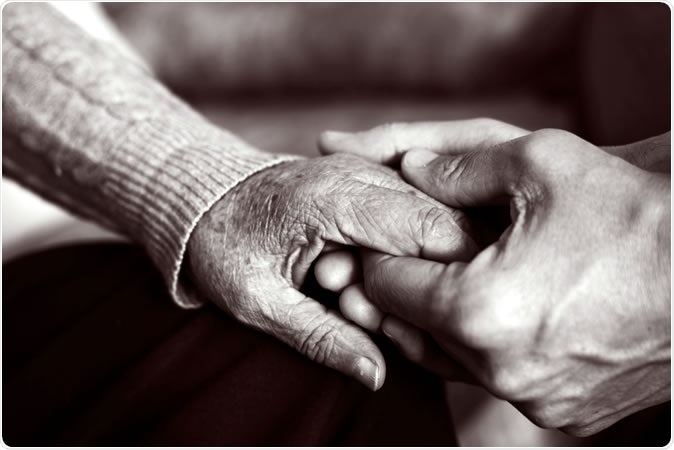Frailty is a term which describes a loss of function as a human being over a range of physiological parameters, both physical and emotional, along with an increased susceptibility to stressful circumstances.
The presence of frailty reduces the quality of life, and increases the risk of adverse health events and outcomes such as falls and related injuries, loneliness, the risk of long-term care in an assisted-living facility, the risk of hospitalization and earlier death.
Now, a new series of papers on Frailty published in the Lancet shows the current position of medical thought on how to prevent, treat and detect frailty; the impact of the condition on people all over the world. They also discuss the effects of frailty on health, on the healthcare system, and social expenditure.
The authors conclude with recommendations on how to manage this increasingly prevalent condition, based on the best available evidence.

Image Credit: Nito / Shutterstock
Assessment of frailty
In earlier work, the researchers involved in the current study described frailty as a condition in which the individual demonstrates three or more features out of five frailty criteria. Another diagnostic criterion involved the frailty index that sums up cumulative age-linked diseases and disabilities. Frailty assessment may also be done on the basis of the Clinical Frailty Scale (CFS), the measurement of gait speed, the Groningen Frailty Indicator, the Edmonton Frail Scale, and the FRAIL score. The chief requirements of a clinically useful frailty assessment tool are that it must be simple and quick, and must help make clinical decisions.
The lack of a standardized definition means that estimates of frailty prevalence vary from 4% to 59% across different studies, with most of these instruments not having undergone extensive validation with respect to the outcome prediction, reliability, cross-cultural applicability and sensitivity. Nowadays, electronic instruments that can be used specifically in certain groups are becoming more widely used, such as the electronic Frailty Index (eFI) and the Hospital Frailty Risk Score, both of which retrieve information on health issues of the individual patient from electronic health records, without the need for doctors to gather any other information.
Frailty: importance in clinical practice
The current paper on Clinical Practice and Public Health, Linda P. Fried emphasizes two main results of present-day research. First, it is possible to foresee the occurrence of adverse outcomes due to frailty. Secondly, frailty as a clinical entity follows upon the biologic entity called aging, but is significantly increased when the person is already sick or has certain other diagnoses. Frailty covers physical, social and psychological factors. It is a dynamic rather than a static state, and a frail person can therefore recover varying degrees of strength and health if appropriate interventions are made before the point of no-return, when the individual becomes so frail as to be dying. Hence the importance of detecting risk factors, which can indicate the appropriate intervention required to slow their effect on promoting frailty, and prevent frailty itself.
Risk factors for frailty
Frailty is experienced to a greater extent by aging adults as a whole but should not be considered a normal part of growing older. However, the risk of frailty is increased when there are co-existing health issues such as heart disease, dementia or metabolic disease. Poverty, low educational levels, and a poor social position are independent risk factors. An inadequate diet and lack of physical exercise are also predictors of future frailty. Women are at greater risk and especially as they grow older.
The importance of identifying these predictors lies in the fact that they are modifiable provided preventive strategies are employed and the individual is offered targeted interventions. As a result, the concept of frailty is one that is being used more and more often in primary care, emergency rooms and by specialists.
Management of patients using frailty measures
In primary care, frailty should be screened for in adults with chronic debilitating illnesses, with unhealthy lifestyles, and/or psychosocial barriers to living a more healthy way. This will help the doctor ask about and address such factors to prevent the development of frailty in this group. It will also help to consider the risks of taking multiple prescription and over-the-counter medications, and the difficulties of having to visit multiple specialists for different disorders. All this could make it harder for the patient to remain healthy.
Once such individuals have become acutely sick, frailty assessment will help decide what type of testing and treatment can be tolerated by and will benefit the patient most. In many interventions, such as surgery for coronary heart disease, frailty is linked to poorer outcomes. And finally, knowing how frail the individual patient is will help decide whether to involve geriatric specialists and rehabilitation specialists in the care of the patient to assure an optimal recovery of functional status.
A lot of work remains to be done to understand how best this concept can help in managing elderly patients in daily medical practice, and how it can be prevented by targeting areas like aging-related loss of appetite, undernutrition, physical inactivity, loneliness, hormonal imbalances, and alterations in physiological functions.
Journal reference:
Frailty: implications for clinical practice and public health. Emiel O.Hoogendijk, Jonathan Afilalo, Kristine E Ensrud, Paul Kowal, Graziano Onder, & Linda P Fried. The Lancet. Frailty| Volume 394, Issue 10206, P1365-1375, October 12, 2019. https://doi.org/10.1016/S0140-6736(19)31786-6. https://www.thelancet.com/journals/lancet/article/PIIS0140-6736(19)31786-6/fulltext